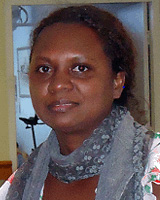Dear Editor
We thank Negin, Martiniuk, Farrell and Dalipanda for their contribution in Rural and Remote Health to the field of inter-island referrals in the Solomon Islands1. We agree that the provision of quality health services to people in remote areas is central to global efforts to achieve universal access to health care. We note with interest their findings that outline the increasing costs involved in referring patients to the National Referral Hospital (NRH) from the provinces, and the current Ministry of Health and Medical Services (MHMS) under-budgeting for these costs.
We also note that administrators and clinicians from NRH classified many referrals as inappropriate. 'Inappropriate referral' was deemed to have occurred where:
- Care required was available at the outer-island facility.
- The care required was not available at NRH, making the transfer futile.
The article, however, did not provide a distinction between 'inappropriate referrals' of health-facility referred patients or self-referred patients. We believe that an expanded investigation of 'inappropriate referral' could include this distinction as well as other aspects, such as patients who should have been referred but were not, and late referrals.
We were encouraged that insights from administrators and policy-makers were included in the study; however, given the topic was inter-island referrals, we were surprised that only one of the 11 interviewees was from an inter-island hospital, and that data from this interviewee was not highlighted. There is much to learn from health workers and patients from rural and remote hospitals to enable a more complete understanding of inter-island referrals.
Here we present a brief overview of experience in engaging with the referral system from the perspective of the most remote hospital on the island of Malaita, Solomon Islands.
Perspective of the most remote hospital
Atoifi Adventist Hospital is the largest non-government hospital in Solomon Islands and one of two hospitals serving 160 000 people on the island of Malaita. The hospital is currently staffed by one doctor and 28 registered nurses. It is located on the remote east coast among rural villages. Transport is by light aircraft, irregular shipping service (often many weeks between ships) or walking along rainforest trails.
Atoifi Hospital receives self-referrals and referrals from clinics in surrounding villages. Staff diagnose and provide medical and surgical care for patients from a variety of social, cultural and religious backgrounds. This requires specific services to be responsive to these needs2-6. Staff also refer selected patients to Kiluufi Hospital in the provincial capital of Auki, and to NRH in Honiara under the following circumstances:
- the doctor is not present at the hospital because of meetings, conferences or other leave
- the hospital lacks diagnostic or surgical equipment or facilities
- the patient requires specialist care beyond the clinician's or hospital's capability
- the patient has family in Honiara to provide additional support and care during prolonged hospitalisation
- for specialist clinics conducted by international medical or surgical teams at NRH.
Not having a doctor present at all times and the lack of basic infrastructure at provincial hospitals is crucial to understanding inter-island referrals.
When provincial hospitals are left without a doctor, nurses often refer patients to NRH to enable them to receive appropriate medical care. While administrators and clinicians in Honiara may deem that care required was available in the provincial hospital, this may not be the case if the doctor is not present or equipment or infrastructure is inadequate.
Many doctors and nurses at provincial hospitals have good generalist knowledge; however, if the doctor or nurse is unable to provide diagnosis or treatment, they refer patients to NRH. This is particularly the case when diagnostic tools and equipment are not available, or not functioning, or when basics such as electricity and water are not available. For example, Atoifi Hospital provides its own electricity from hydroelectric and diesel generators. There have been extended periods (months and in some cases years) where the hydroelectric system had insufficient water (due to dry periods) or breakdowns have required specialist repair/upgrading. During such periods diesel generators provide electricity for only a few hours per day. This severely limits the use of diagnostic equipment or the use of treatment and monitoring devices for patients. Such situations mean patients by-pass the provincial hospital and go directly to the NRH, or that patients initially admitted are referred to the NRH.
Doctor shortages in remote hospitals are exacerbated by the fact that many experienced doctors and nurses choose to work in Honiara rather than remote hospitals such as Atoifi. Their reasons include social and professional isolation and the lack of opportunity for ongoing professional development for clinicians in Honiara. This impacts the capacity of remote hospitals to comprehensively respond to complex presentations in rural areas and, thus, increases referrals to NRH.
The referral policy is also not well understood by many people attending remote hospitals. Nor, as highlighted by Negin et al1, is the policy enforced by MHMS. This leads to frequent by-passing of the closest facility or provincial hospital by service-seeking families or individuals who wish to access the highest level of care for themselves or their family member. Inter-island ferries and flights that travel directly to Honiara increase the by-passing of rural health facilities and may increase the burden on the NRH and uneven case loads at the clinics and hospitals throughout the country.
Conclusion
Incorporating perspectives from the rural and remote hospitals and communities from which the referred patients originate will provide greater depth of understanding of referral patterns in the Solomon Islands and other similar settings. This will also allow a more nuanced and informed response to improving the health system in the country. Our experience at a remote hospital in Malaita province shows that there are number of 'push and pull' factors that influence the number of inter-island referrals to NRH. Greater resources and opportunities, including more Clinicians, equipment and training at the provincial level, along with clearer referral processes, and a greater understanding by the public of the role of provincial services could go some way to address the high burden of referrals to NRH.
Acknowledgements
The authors thank Dr Peter Massey and Ms Michelle Redman-MacLaren for their input and comments on this manuscript.
Humpress Harrington MAdvEd1, Rowena Asugeni BN2 & David MacLaren PhD3
1Atoifi College of Nursing, 2Atoifi Adventist Hospital, Malaita, Solomon Islands
3School of Medicine and Dentistry, James Cook University
Cairns, Queensland, Australia
References
1. Negin J, Martiniuk A, Farrell P, Dalipanda T. Frequency, cost and impact of inter-island referrals in the Solomon Islands. Rural and Remote Health 12: 2096. (Online) 2012. Available: www.rrh.org.au (Accessed 16 April 2013).
2. MacLaren D, Kekeubata E. Reorienting health services through community health promotion in Kwaio, Solomon Islands. Promotion & Education 2007; 14(2): 78-79.
3. MacLaren D, Asugeni J, Asugeni R, Kekeubata E. Incorporating sociocultural beliefs in mental health services in Kwaio, Solomon Islands. Australasian Psychiatry 2009; 17(Suppl 1): S125-127.
4. Redman-MacLaren M, MacLaren D, Solomon J, Muse A, Asugeni R, Harrington H et al. Research workshop to research work: initial steps in establishing health research systems on Malaita, Solomon Islands. Health Research Policy and Systems 8: 33. (Online) 2010. Available http://www.health-policy-systems.com/content/8/1/33 (Accessed 16 April 2013).
5. Redman-Maclaren ML, MacLaren DJ, Asugeni R, Fa'anuabae CE, Harrington H, Muse A et al. "We can move forward": challenging historical inequity in public health research in Solomon Islands. International Journal for Equity in Health. 2010; 9: 25. (Online) 2010. Available: http://www.equityhealthj.com/content/9/1/25 (Accessed 16 April 2013).
6. Massey P, Wakageni J, Kekeubata E, Maena`adi J, Laete`esafi J, Waneagea J et al. TB Questions, East Kwaio Answers: community based participatory resarch in a remote area of Solomon Islands. Rural and Remote Health 12: 2139. (Online) 2012. Available: www.rrh.org.au (Accessed 16 April 2013).


